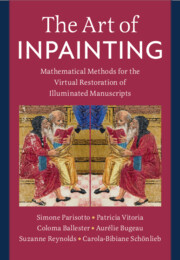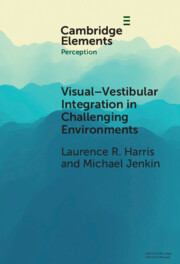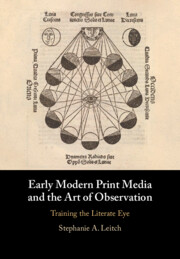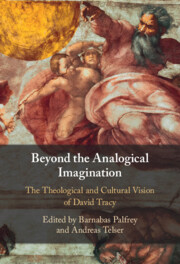Refine search
Actions for selected content:
212 results
Chapter 6 - Visual Space
-
- Book:
- The Neural Structure of Consciousness
- Published online:
- 27 July 2025
- Print publication:
- 18 September 2025, pp 172-201
-
- Chapter
- Export citation
23 - Creativity and visioning
- from Part 5 - Drives Innovation
-
-
- Book:
- Leading and Managing Health Services
- Published online:
- 15 August 2025
- Print publication:
- 28 August 2025, pp 258-267
-
- Chapter
- Export citation

The Art of Inpainting
- Mathematical Methods for the Virtual Restoration of Illuminated Manuscripts
-
- Published online:
- 22 May 2025
- Print publication:
- 22 May 2025
Sensory Horizons and the Functions of Conscious Vision
-
- Journal:
- Behavioral and Brain Sciences / Accepted manuscript
- Published online by Cambridge University Press:
- 21 April 2025, pp. 1-53
-
- Article
-
- You have access
- Export citation

Visual-vestibular Integration in Challenging Environments
-
- Published online:
- 09 December 2024
- Print publication:
- 30 January 2025
-
- Element
- Export citation
Conclusion
-
- Book:
- The Mirror of Art
- Published online:
- 28 November 2024
- Print publication:
- 28 November 2024, pp 355-360
-
- Chapter
- Export citation
Chapter 7 - The Threshold of Vision
- from Part II - On Literary History
-
- Book:
- The Possibility of Literature
- Published online:
- 10 October 2024
- Print publication:
- 05 September 2024, pp 149-168
-
- Chapter
- Export citation
A Tribute to Professor Charity Scott
-
- Journal:
- Journal of Law, Medicine & Ethics / Volume 52 / Issue 2 / Summer 2024
- Published online by Cambridge University Press:
- 22 October 2024, pp. 219-223
- Print publication:
- Summer 2024
-
- Article
- Export citation
Transcending the fog of war? US military ‘AI’, vision, and the emergent post-scopic regime
-
- Journal:
- European Journal of International Security / Volume 10 / Issue 2 / May 2025
- Published online by Cambridge University Press:
- 30 May 2024, pp. 190-210
-
- Article
-
- You have access
- Open access
- HTML
- Export citation

Early Modern Print Media and the Art of Observation
- Training the Literate Eye
-
- Published online:
- 14 March 2024
- Print publication:
- 04 April 2024
I.20 - Felix, The Life of St Guthlac
- from Eighth Century
-
- Book:
- The Cambridge Anthology of British Medieval Latin
- Published online:
- 11 January 2024
- Print publication:
- 01 February 2024, pp 238-246
-
- Chapter
- Export citation
Ophthalmic and Neuroimaging Associations In Optic Nerve Hypoplasia/Septo-Optic-Pituitary Dysplasia
-
- Journal:
- Canadian Journal of Neurological Sciences / Volume 51 / Issue 5 / September 2024
- Published online by Cambridge University Press:
- 05 January 2024, pp. 672-678
-
- Article
- Export citation

The Poetics of Prophecy
- Modern Afterlives of a Biblical Tradition
-
- Published online:
- 14 December 2023
- Print publication:
- 21 December 2023
ΤWO BEGINNINGS: ACROSTIC COMMENCEMENTS IN HORACE (EPOD. 1.1–2) AND OVID (MET. 1.1–3)
-
- Journal:
- The Classical Quarterly / Volume 73 / Issue 2 / December 2023
- Published online by Cambridge University Press:
- 18 March 2024, pp. 699-713
- Print publication:
- December 2023
-
- Article
- Export citation
Chapter 4 - Omni ecclesiastica dignitate nobilitavit: “Good King Dagobert”
- from Part II - Bears and Wolves
-
- Book:
- The Merovingians in Historiographical Tradition
- Published online:
- 02 November 2023
- Print publication:
- 16 November 2023, pp 170-222
-
- Chapter
- Export citation
6 - Training the Senses
-
- Book:
- Knowledge, Faith, and Early Christian Initiation
- Published online:
- 11 October 2023
- Print publication:
- 19 October 2023, pp 134-154
-
- Chapter
-
- You have access
- Open access
- HTML
- Export citation
Introduction
-
-
- Book:
- Beyond the Analogical Imagination
- Published online:
- 28 September 2023
- Print publication:
- 12 October 2023, pp 1-18
-
- Chapter
- Export citation

Beyond the Analogical Imagination
- The Theological and Cultural Vision of David Tracy
-
- Published online:
- 28 September 2023
- Print publication:
- 12 October 2023
Chapter 4 - Translating an Embodied Gaze
- from Part I - Translation as Medium and Method
-
-
- Book:
- Performance and Translation in a Global Age
- Published online:
- 10 August 2023
- Print publication:
- 29 June 2023, pp 87-103
-
- Chapter
- Export citation
1 - Principles and Consequences of the Initial Visual Encoding
-
-
- Book:
- New Handbook of Mathematical Psychology
- Published online:
- 20 April 2023
- Print publication:
- 27 April 2023, pp 1-41
-
- Chapter
-
- You have access
- Export citation
